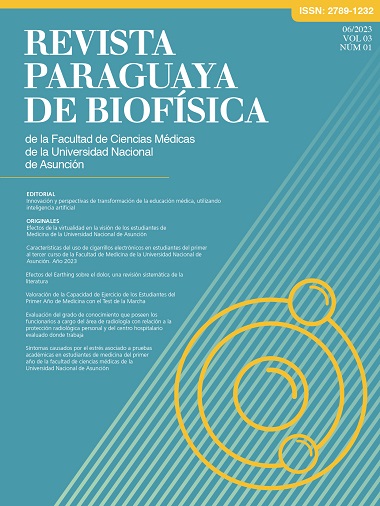Effects of virtuality on the vision of medical students at the National Uni- versity of Asuncion
Keywords:
virtuality, education, visual health, studentsAbstract
Introduction: The COVID-19 pandemic led to a boom in the creation of virtual jobs to provide education that could no longer be offered in physical classrooms. Children, young people, and adults were forced to spend hours in front of screens, more than they usually did. Every day, the population spent more hours than recommended in front of display screens.This study aimed to determine the effect of virtuality on the visual health of medical students.
Materials and Methods: This cross-sectio- nal, descriptive, and observational study had a quantitative approach and was conducted from January 16, 2022, to February 16 of the same year, at the FCM-UNA. A digital survey using Google Forms was sent to the participants for collecting the data relevant to the study. The data collected was used anonymously and exclusively for research purposes, the collection of these data was carried out on a completely voluntary basis following the rules of the FCM-UNA
Results: Of the 205 students surveyed, 131 were female and 75 male. The average age of the sample population was 22 years. From 2020 to February 2022, 65.5% of the participants experienced a deterioration in their visual health. Regar- ding the use of glasses, a vast majority of the population (64.1%) wore glasses. A decrease was observed in the graduation of the users‘ lenses since the implementa- tion of virtual classes, primarily relating the use of lenses to myopia. Headaches were found to be the most common symptom experienced by the students.
Conclusions: The implementation of virtual classes affected all students, regardless of whether they wore glasses or not. This is indicated by the fact that the vast majority (77%) presented symptoms of computer vision syndrome (CVS). Regarding lens users, taking into account the increase in the po- wer of their prescription eyeglasses, it was concluded that the continuous and excessive use of digital study materials directly affected their visual health.
Downloads
References
(1) Makachov A. National Eye Institute. 2019. https://www.https://www.nei.nih. gov.
(2) HirschL.KidsHealth.2019.https://kidshealth.org/es/parents/eyes.html?ref=search
(3) Dossari SK, AlZahrani R, Alutaibi H, Al Shuhayb B, Alsultan T, Albenayyan HA, Al Furaikh BF. The Effect of Online Education on Healthy Eyes of Saudi Teachers in the COVID-19 Pandemic: A Local Study. Cureus. 2022 May 4;14(5):e24721. doi: 10.7759/cureus.24721. PMID: 35673319; PMCID: PMC9165422.
(4) Nivelo-Róman FÁ. Patologías oculares a causa del uso de TICs durante la Pandemia por COVID-19. 2022 https://dialnet.unirioja.es/servlet/articulo?codigo=8483031 EFACIM.
(5) Torres Mazari, M. A., Alfonso Villalba, J., Espínola Ferreira, K., & Torres de Coro nel, M. C. (2020). Prevalencia de vicios de refracción en estudiantes de medicina de la Universidad Nacional de Asunción. Discover Medicine, 4(1),13–20.
(6) Castillo D. Repositorio Digital de la Unversidad Privada Antenor Orrego. 2022. https://repositorio.upao.edu.pe/handle/20.500.12759/8799.
(7) Gerena Pallares, L. C., Vargas Rodríguez, L. J., Niño Avendaño, C. A., Uyaban, G. C., & Ballesteros Virgen, Y. Prevalencia del síndrome visual por computadora en los estudiantes de medicina de la ciudad de Tunja durante la pandemia. Revista Colombiana de Salud Ocupacional. 2022; 12(1), 7916. https://doi.org/10.18041/2322-634x/rcso.1.2022.7916
(8) Lu B, Congdon N, Liu X, Choi K, Lam DS, Zhang M,et al. Associations between near work, outdoor activity, and myopia among adolescent students in rural China: the Xichang Pediatric Refractive Error Study report no. 2. Arch Ophthalmol. 2009 Jun;127(6):769-75.
(9) Battersby, K., Koy, L., Phillips, N., Sim, J., Wilk, J., & Schmid, K. L.. Analysis of physical activity in emmetropic and myopic university students during semester and holiday periods: a pilot study. Clinical and Experimental Optometry. 2015; 98(6), 547–554.
(10) Custodio Sánchez K. Trascendencia del síndrome visual informático debido a la exposición prolongada a aparatos electrónicos. Rev. Fac. Med. Hum. 2021.
(11) Coronel-Ocampos J, Gómez J, Gómez A, Quiroga-Castañeda PP, Valladares- Garrido MJ. Computer Visual Syndrome in Medical Students From a Private University in Paraguay: A Survey Study. Front Public Health. 2022 Jul 14;10:935405.
(12) L.J. Vargas Rodríguez, N. Espitia Lozano, H.M. de la Peña Triana, J.L. Vargas Vargas, D.M. Mogollón Botía, Á.M. Pobre Vinasco, M.A. Tristancho Rincón, C.A. Acosta Pérez, M.C. Sarria Carreño, G. Contento Suescun, Síndrome visual informático en universitarios en tiempos de pandemia, Archivos de la Sociedad Española de Oftalmología. 2023; Volume 98, Issue 2: 72-77,
(13) Fernandez-Villacorta, A.N. Soriano-Moreno, T. Galvez-Olortegui, N. Agui- Santivañez, D.R. Soriano-Moreno, V.A. Benites-Zapata, Síndrome visual informático en estudiantesnn universitarios de posgrado de una universidad privada de Lima, Perú, Archivos de la Sociedad Española de Oftalmología.2021; Volume 96, Issue 10: 515-520
(14) Ayala Servín Nicolás, Duré Marcia Antonella, Franco Enrique Daniel, Lajarthe Ana María, López Rodrigo David, Rolón Derlis Javier et al . Utilización de las tecnologías de la información y comunicación (TIC) en estudiantes universitarios paraguayos. An. Fac. Cienc. Méd. (Asunción) [Internet]. 2021 ; 54( 1 ): 83-92.
Downloads
Published
How to Cite
Issue
Section
License
Copyright (c) 2023 Autores

This work is licensed under a Creative Commons Attribution 4.0 International License.





